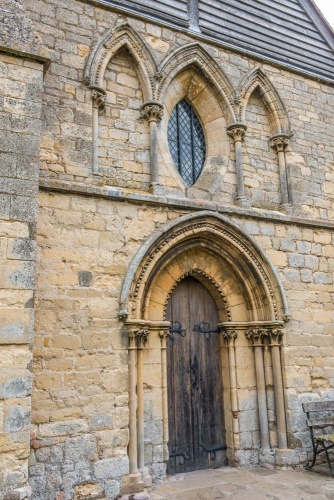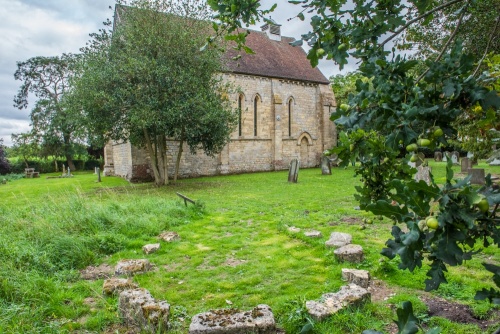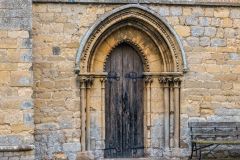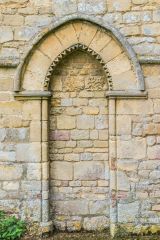
In 1139 Hugh the Breton founded a Cistercian monastery near the River Witham at Kirkstead, Lincolnshire. Kirkstead Abbey was a daughter house of Fountains Abbey in Yorkshire, with a dozen monks under an abbot.
History
Hugh the Breton's grandson was Roger de Tattershall, who died in 1212. Around 1230 Robert's descendants built a chantry chapel outside the Kirkstead Abbey gates. The chapel was called St Leonards Without because it stood just outside (without) the abbey precinct.
The Abbey was suppressed by Henry VIII in 1537 and the last abbot and three monks were executed. The chapel, however, was spared because it was not directly part of the monastery and was in use by the local community.

In the 18th century, Daniel Disney took ownership of a part of the abbey site through an advantageous marriage. Daniel Disney was an ancestor of the famous film-maker, Walt Disney.
Around 1720 Daniel Disney bequeathed money to support a Protestant Minister for St Leonard's Chapel. The Chapel was closed for worship in 1877 and saved from destruction by The Society for the Protection of Ancient Buildings. The society restored the church in 1913 and it continues in use as a parish church.
The chapel is a very simple rectangular building consisting of just one vaulted chamber. It is approximately 12.8 metres (42 feet) x 5.8 metres (19 feet). Aside from the restored roof, it is unchanged from its early 13th-century condition. The roof timbers are decorated with beautifully carved bosses including a figure of the Agnus Dei, or Lamb of God.
The nave is separated from the chancel by a screen that retains sections of original 13th-century arcading. These carved sections of the screen are among the earliest examples in Britain. The medieval arcading rests on a new base installed in 1926.
The font is a medieval mortar re-purposed as a baptismal font, and rests on a cylindrical stone base. The mortar may have come from the medieval abbey kitchen.

Near the altar is a broken marble effigy of a knight, thought to represent Roger de Tattershall. Only the upper part of the knight's torso is intact and shows him clad in chain mail and holding a sword and shield. The effigy is shown wearing a flat-topped casque (a form of knight's helmet).
Only seven other helmeted effigies of this style are known in Britain. They are characterised by narrow eye slits but no air holes to make breathing easier. They were first worn around 1200 but were improved with the addition of air holes around 1225, so we can date the effigy quite accurately to the period between those two dates. The style of mail coat is also quite rare, with only three other British examples known.
The effigy is one of the earliest military effigies in an English church. Also in the chancel is a triangular-headed aumbry.

The exterior of the church is notable for the large west doorway. Though the door itself is a replacement, the scrolled iron hinges are original to the 13th-century chapel. The doorway itself is of three orders with shafts supporting stiff-leaf capitals, while the archway is decorated with traditional Norman dogtooth carving. There are five slender single lancet windows in the north wall and six in the south wall. The east end has three larger lancets.
The exterior is extremely plain, almost spartan aside from the west facade with its 13th-century stonework. The church is built of limestone blocks quarried at Lincoln and is capped by a modern clay tile roof. Curiously, both gable ends have weatherboarding under the gable rather than stonework.
In the north-east corner of the churchyard is a collection of carved stones from Kirkstead Abbey, arranged in a circle.

Getting There
There are no obvious signs for Kirkstead Abbey or St Leonard's Church on nearby roads, but getting there is straightforward. From the B1192 Tattershall Road turn onto Abbey Lane at the Abbey Lodge pub. Follow Abbey Lane to the sharp right been. There is a large parking area on your left. There you will find an information panel on the history of Kirkstead Abbey, which is visible in the farm field ahead.
Just follow the obvious track directly through the abbey site, passing directly beside the upright remains of the south transept arch, and continue across the field. You will pass the monastery moat at the edge of the field. Just ahead in a wooded glade is St Leonard's Church.
Be aware that the church is kept locked, but you can easily arrange to view the interior by contacting the keyholder (see the official church website). Unfortunately, we weren't able to make arrangements to view the interior when we visited, but we're hoping to return and take photos of the 13th-century effigy and screen.
About Kirkstead, St Leonard's Church
Address: Kirkstead Abbey, Abbey Lane, Kirkstead,
Lincolnshire,
England, LN10 6UH
Attraction Type: Historic Church
Location: On a footpath past Kirkstead Abbey, off Abbey Lane. Parking at the bend on Abey Lane, just off the B1192.
Website: Kirkstead, St Leonard's Church
Location
map
OS: TF190613
Photo Credit: David Ross and Britain Express
HERITAGE
 We've 'tagged' this attraction information to help you find related historic attractions and learn more about major time periods mentioned.
We've 'tagged' this attraction information to help you find related historic attractions and learn more about major time periods mentioned.
Find other attractions tagged with:
NEARBY HISTORIC ATTRACTIONS
Heritage Rated from 1- 5 (low to exceptional) on historic interest
Kirkstead Abbey - 0.4 miles (Abbey) ![]()
Petwood House Garden - 1.5 miles (Garden) ![]()
Tattershall College - 2.6 miles (Historic Building) ![]()
Tattershall Castle - 2.7 miles (Historic House) ![]()
Tattershall Church - 2.7 miles (Historic Church) ![]()
Haltham-on-Bain, St Benedict's Church - 3.8 miles (Historic Church) ![]()
Scrivelsby, St Benedict's Church - 5.4 miles (Historic Church) ![]()
Horncastle, St Mary's Church - 6.6 miles (Historic Church) ![]()
Nearest Holiday Cottages to Kirkstead, St Leonard's Church:
Woodhall Spa, Lincolnshire
Sleeps: 6
Stay from: £689 - 2420
Woodhall Spa, Lincolnshire
Sleeps: 6
Stay from: £482 - 2458
More self catering near Kirkstead, St Leonard's Church










